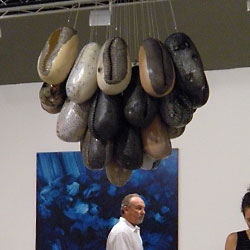Art Basel Miami: Overwhelming, but worth it

(Joyce Edmondson)
Over the weekend, I got lost in a sea of art at Art Basel Miami.
The 12th annual art fair, held in the cavernous Miami Beach Convention center, featured 250 galleries showing Modern and contemporary art. It’s a fair intended for collectors -- though it certainly attracts art lovers of all types (all 50,000 of us.)
No one could connect with all the work they saw at Art Basel, but everyone came away with memorable images and experiences. If you love art, then one year soon, you need to head to Miami Beach in December. After you passed through security, unless you were a collector on a mission, you were free to roam unencumbered. Guards were abundant but detached, which gave a person breathing room to get right up on pieces and examine them.
While lost in the galleries, I was able to admire many contemporary masterworks as well as current, cutting-edge pieces. Looking at the art, it seemed too easy to zero in on large, audacious sculptures and installations when really, there was so much more. There was a tremendous mix of art, from Andy Warhol, Vassily Kandinsky, Fernando Botero, Max Ernst and Fernand Léger to very new pieces by Yoshimoto Nara, Barbara Kruger, Reena Saini Kalatt and much more. The whole gamut of contemporary art was represented at Art Basel Miami, from cubism to minimalism, expressionism to conceptualism.
Some of my favorites were the kinetic sculptures and mobiles by George Rickey and Alexander Calder. While mostly made of metal, they felt organic, delicate, responding to forces around them. These sculptures are alive, not just hunks of metal sitting there, corroding. I also very much enjoyed the PPOW gallery who was showing the works of Carolee Schneemann. There were photos and videos of her beautiful yet shocking performance pieces as well as some of her constructions.
Collecting can be a challenge if the work is ephemeral or conceptual. Nonetheless, you could tell Art Basel was aimed at investors because almost every piece of art stated its provenance, where it had sold previously (if applicable) and (if you ask) for how much. Armed with that information, buyers could then easily gain an understanding how the art may appreciate in value.
 Simone Leigh's "You Don't Know Where Her Mouth Has Been II," 2013 |
I only stumbled onto prices twice. Once was while inquiring the title of a hanging sculpture, which was Simone Leigh's "You Don't Know Where Her Mouth Has Been II." The gallery rep must have misunderstood me as she quickly volunteered, “We’re asking $100,000.”
The second time, I was asking about the name of an artist, when a young man told me, “It’s ‘Isla.’”
“Is that the name of the artist or the piece?”
He wrote it on a card for me, “Isla,” by José Carlos Martinat.
“Is the art for sale?” I asked.
“Oh sure,” he said.
“And, are you the artist?”
“Yes,” he replied.
“How much are you asking for this?” (As soon as I blurted that out I was sorry I did so.)
“Oh, ahhh… ummm,” he said, looking about for his rep. “Thirty thousand I believe. Yes, that’s it.”
You can see “Isla” in the photo gallery above. In person, I must say this kinetic sculpture was really fantastic. Two palm trees were shedding personal narratives from bank adding machines where coconuts ought to be. I wondered, if one bought this piece, would one own the history the piece was creating as well as the stories it spewed out? And, who would replace the paper in the adding machines? You would own the maintenance too, I am sure.
The crowd at Art Basel was amazingly huge but equally amazingly well-behaved. The people were art themselves -- all ages, nationalities, genders (or non-genders as Eva and Adele, performance artists from Berlin). It was good to see so many young people and students interested, snapping photos of the art. Organized groups followed tour guides, listening in via wireless headsets.
Some overheard snippets of conversations included:
(Two men standing in front of a four-panel art work)
“Let’s buy it. How much is it?”
“He wants $1 million for the two.”
“Well, why don’t we buy them?”
“I’ll have to see… we may need to form an LLC first.”
(I wondered if they were really discussing art or real estate.)
Lots of snippets like this: “My lord, look at that Max Ernst. That’s a good, early Ernst, too, WOW.”
Then I heard, “Hey, I’m just here because I could get out of school for a day.”
A lot of art addressed the topic of mass consumption -- the commercialization of our lives. Yet, I thought, isn’t this art the desirable object of consumption? I am still wrestling with that conundrum. Perhaps the question is the answer – Yes, that must be it, to question is the reason for the art.
Deep in theory, I realized the experience was getting overwhelming. I knew I was overwhelmed when I started seriously considering paying $20 for a glass of champagne (and the champage brand was, ironically, “Ruinart.”)
I guess then, there’s only one more thing to say, or rather, not say, but show:

[Sam Durant's "No More Words," 2013]
